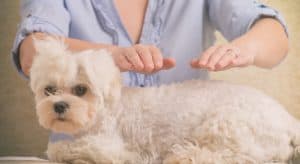Whether you have adopted a puppy, adult or geriatric dog, he is new to your home. Therefore, you must act as if he’s a brand new baby puppy in the amount of supervision you provide. That is especially true on the first day.
Whether you have adopted an Owner Surrender, a Domesticated Stray, or Street Stray Dog, it will be important to act as if you are dealing with a blank slate, tabula rasa, as it were when introducing him to his new home.
You want your newly adopted dog’s first day to be as fear-free as possible. You want to provide proper leadership and consistency as you acclimate him to his new surroundings.
Puppy Proof Your Home
Before you pick your furry bundle of joy up from the animal shelter, you should puppy-proof your home. All dogs like to explore and we do not want any mishaps, especially on the first day. So make sure the house is neat and orderly.
Making sure that there is nothing inappropriate that the dog can get into. So no stray shoes in the foyer, no prize possessions in the reach of the new dog.
And of course, keep dangerous objects out of reach; such as electrical cords. When puppy-proofing, act as if you were preparing for a young puppy, no matter what age or previous circumstances your new edition may have had.
Be Prepared
Also, make sure you have everything you need for your new arrival. Food, treats, food and water bowl, a crate, a leash and collar, a few toys, dog bed, and blanket. Being prepared will go a long way in having a successful first day.
First Day Plan
Most importantly, make sure you have a First Day Plan! Here is an example plan. You should tailor this plan to your specific situation.
As you make your first day plan, the two most important tips are:
- 100% supervision at all times. This will involve keeping him on a leash when not in his crate. This will prevent mishaps, miscommunication, and initial housebreaking problems. It will also help with bonding with the members of the household; as you are always physically connected.
- Don’t let your dog do anything on day one that he is not allowed to do on day two or any other day in the future. For example, if you do not want your dog on the couch as a general rule, then do not allow him on the couch on his first day, just because you feel sorry for him or want him to feel safe.
First Day Plan
An example First Day Plan for your newly adopted dog:
Brief Walk
When you leave the animal shelter, have the dog take a brief walk and relieve himself before putting him in your car.
Transport
Transport the dog as you would any other day of your dog’s new life! Meaning if you plan on using a dog seat belt. For example, do not let him sit in your lap during the drive because it’s his “first day” with you. We do recommend some type of crate or dog seat belt in order to ensure safety.
Don’t Rush On Arrival Into New Home
Once you arrive home, don’t rush into the house with your new dog. Let him walk around smell the wonderful smells and see the wonderful sights of his new yard and let him use the restroom.
It would make sense to pick a ‘special spot’ now as his new place to go pee-pee. Give him a good 10 or 15 minutes in this area.
Show Him Around With Leash
Next, you should bring the dog to the house and show him the lay of the land! But remember don’t drop the leash and make it a free-for-all. Remember, incorporated in your plan should be 100% supervision and ‘no special indulgences’ because it’s the first day.
Take him through your home on a leash. Depending on his background and age he could be excited, nervous, exuberant, or anxious. He could be panting and wanting to lunge at the end of the leash in order to pace around. Or he could be looking as if he’s ‘frozen in time’. Not wanting to walk around at all; thinking one false move may bring danger.
I know it all sounds very dramatic but you have no way of knowing what your dog’s true personality is and how he reacts to something completely new.
Marking Territory / Accident
Another reason to keep him on a leash during your entrance into the home is very important and has to do with the fact that he may mark his territory or simply have an accident for a variety of reasons.
If this were to happen you would want to say no with a low pitch voice and bring the dog immediately outside to the ‘special spot” that you introduced him to earlier in order to relieve himself.
The article on Housebreaking Hints could be very helpful in this situation.
Introduce The Crate & Encourage
Once your dog has explored the home on a leash, you should take him over to his crate if you are planning on crate training him.
It would make sense to have some toys already inside of the crate along with some bedding and maybe a few treats. Encourage your dog to go into the crate to take a toy or treat. Do not force him in. He may be comfortable with a crate from his previous home or he may have never seen one before in his life!
Chance To Settle With New Family
Next, give the dog a chance to settle down a bit. Have your family interact with him without overwhelming him.
This would be a good point to have some downtime. You can sit with him. But if you plan on sitting with him, do not sit on the couch with him if your plan is to have the couch off-limits after day 1!
You must be consistent. Know what your rules are in advance and show him what your rules are from day one. So if the couches off-limits, sit on the floor with him. Or put him in his crate for a break
Frequent Visits To Urinate
After a little break, you may want to take him out again to his special spot to urinate. In fact be sure to take your dog out to his spot, every 20 minutes or so during this acclimation process. At this point, he has no schedule and you don’t know his urination habits.
At this point, whatever time of day it happens to be, start following whatever schedule it is that you’ve had planned for the dog. This includes feeding time, nap time, exercise time, training time, and alone time.
Regular Feeding Times
Most people feed their dogs twice a day. Feeding should be at set times each day. Even on the weekends. This will create predictability and assist with consistent housebreaking.
Exercise / Training & Nap Times
Exercise time, Training Time, and Nap Time should occur two to three times a day. Preferably in this order.
If the dog burns off some energy, he will be paying more attention when you practice obedience training with him. Now the dog has burned off his ‘brain’ energy from the training time he will be ready for a good nap!!
Alone Time
Alone time is very important. Especially on the first day. A common mistake people make is that they pick up their newly adopted dog on a Friday or Saturday. They spend the entire weekend with the dog; 24/7. Then they rush off to work on Monday. Only to leave the dog confused, shaken, and anxious.
So make sure on the ‘First Day’ and ‘Every Day’ that your dog has periods of time where he is alone.
In some instances, you will go out, even if it’s just to go to the store for 20 minutes. And other instances it will be longer. He needs to know that you will be gone on a daily basis at an unknown time of day for an unknown amount of time.
Continue With Adjustments If Necessary
Once you get through your first-day plan successfully using 100% supervision, consistency with the ‘do’s and don’ts’ of the household, you should be prepared to carry that into the 2nd, 3rd 4th, and 5th days, etc.
Make adjustments each day if you’re having trouble with behaviors such as housebreaking, sleeping patterns, feeding, exercise, napping, or training times, We recommend you leave the leash on as a form of supervision for a couple of weeks.
Of course, never leave the leash on if your dog is unattended. If you need a break, you can always put your dog in his crate. Over time, give him off-leash access to the house. But do this one room at a time. Don’t rush the process. You have a lifetime together!
By applying these tips, your first day will go much more smoothly and give your dog the security of having a routine and Leadership. This will help the dog adjust to his new home much quicker and with fewer mishaps.







